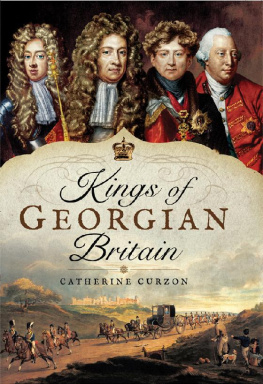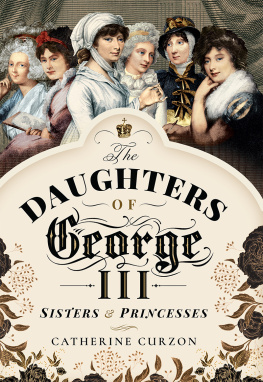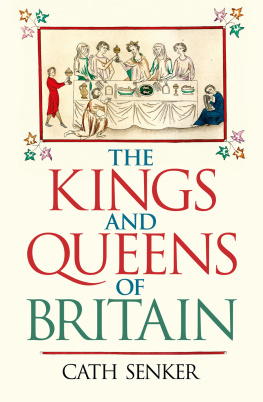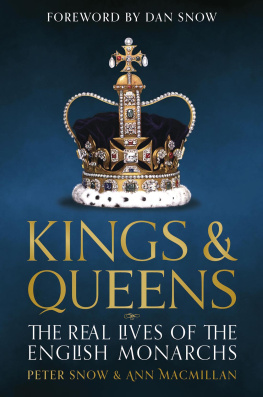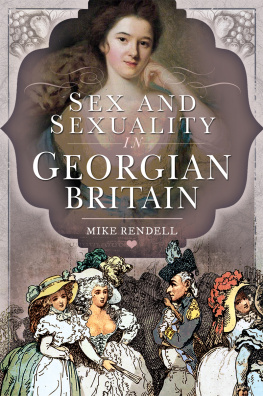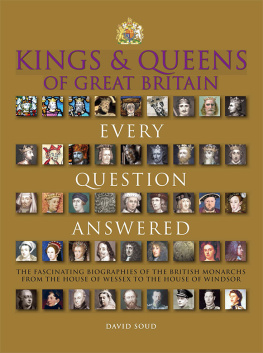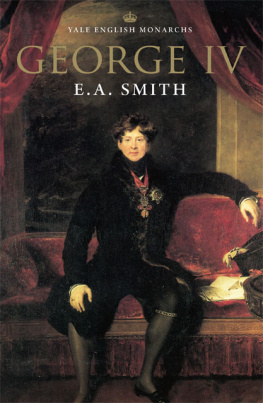Kings of Georgian Britain
For the rakish Colonial, brewer of teas.
Kings of Georgian Britain
Catherine Curzon
First published in Great Britain in 2017 by Pen & Sword History an imprint of Pen & Sword Books Ltd
47 Church Street
Barnsley
South Yorkshire
S70 2AS
Copyright Catherine Curzon 2017
ISBN 978 1 47387 122 9
eISBN 978 1 47387 124 3
Mobi ISBN 978 1 47387 123 6
The right of Catherine Curzon to be identified as Author of this work has been asserted by him in accordance with the Copyright, Designs and Patents Act 1988.
A CIP catalogue record for this book is available from the British Library All rights reserved. No part of this book may be reproduced or transmitted in any form or by any means, electronic or mechanical including photocopying, recording or by any information storage and retrieval system, without permission from the Publisher in writing.
Pen & Sword Books Ltd incorporates the Imprints of Aviation, Atlas, Family History, Fiction, Maritime, Military, Discovery, Politics, History, Archaeology, Select, Wharncliffe Local History, Wharncliffe True Crime, Military Classics, Wharncliffe Transport, Leo Cooper, The Praetorian Press, Remember When, Seaforth Publishing and Frontline Publishing.
For a complete list of Pen & Sword titles please contact PEN & SWORD BOOKS LIMITED
47 Church Street, Barnsley, South Yorkshire, S70 2AS, England E-mail:
Website: www.pen-and-sword.co.uk
Acknowledgements
My warmest thanks go to all the team at Pen and Sword Books, especially the inestimable Heather, who has more than earned her chocolates, to Lucy, for her good humour and sharp editing nib, and of course, to Kate.
A huge thank you is due to all at T&Cake and Bexs in West Yorkshire for keeping me well-fed, full of tea and never at a loss for cake. Endless gratitude also goes out across the world to the wonderful folk who stop by my blog once in a while. You have cajoled, encouraged and kept me on the Georgian royal road!
A special merci must go to Adrian and Caroline for letting me be a small part of Jane Austens world. To the marvellous musicians and performers who bring the eighteenth century to life, never, ever stop.
To friends near and far, to those who list and those who listen, I salute you from here to eternity.
Mayhem and magic to you, Willow Winsham, keep on keeping on.
To Pippa, Nel and Custard, you bring the snuggles. Dont ever stop. And Rick, this one is for you. Are you brewing?
List of Illustrations
Cover illustrations:
King George IV. Robert Bowyer, after John Bromley, 1827. ( Courtesy Wellcome Library, London, under Creative Commons Attribution only licence CC BY 4.0 http://creativecommons.org/licenses/by/4.0/ ) His Majesty King George III returning to Town from Windsor with an Escort of tenth Prince of Wales Own Light Dragoons. Charles Turner, after Richard Barrett Davis, 1806. ( Courtesy of The Yale Center for British Art. Public domain ) The Coronation of King George IV in Westminster Abbey. Charles Turner.
The Grand Coronation Banquet of George IV, in Westminster Hall. W Read.
King George III of the United Kingdom. Etching by W Lowry.
The Coronation of George II. Adolf van der Laan.
The Funeral of George I. Adolf van der Laan.
The South Sea Scheme: speculators ruined by the collapse of the South Sea Company. William Hogarth, 1721.
Georgius D.G. Mag. Britanniae Franciae et Hiberniae Rex. John Benson Lossing.
George I at Newmarket, 4 or 5 October, 1717. John Wootton, 1717.
George II. Johann Leonhard Hirschmann.
George I. Johann Leonhard Hirschmann.
George II. Sandie, 1736.
Georgius IIdus D.G. Mag. Brit. Fran. et Hib. Rex F.D. Sir Godfrey Kneller.
The Pavilion & Steyne at Brighton. James Mitan, after Charles Cracklow, 1806.
King George III. Thomas Frye.
George III and his family visit Dorchester jail. Charles Howard Hodges, 1793.
Carlton House. Anonymous, 1800.
Carlton House, North Front. Richard Gilson Reeve, after William Westall. 1819.
George III, King of Great Britain, France and Ireland etc. Anonymous.
George III. Anonymous, 1789.
George the III, King of Great Britain. Anonymous.
The Coronation Procession of His Majesty King George the IV, July 19th 1821. George Johann Scharf, 1821.
King George III analyzing the residue from a large glass retort containing a small figure satirizing the English view of Napoleon. T West, 1803.
The gouty Prince Regent being helped onto his horse by means of an elaborate contraption outside an oriental pavilion in Kew Gardens. Anonymous, 1816.
George IVs Public Entry into the City of Dublin on August 17th 1821. Robert Havell, 1823.
His Royal Highness George Prince of Wales. Anonymous, 1794.
Coronation Procession of H. M. George IV, 19 July 1821. William Heath.
George the Fourth When Prince of Wales. Anonymous.
Windsor Castle from the Thames. William Daniell, 1825.
Peter, the Wild Boy. Anonymous.
Windsor Castle View King George IV Gate and the Round Tower, 28 July 1832, 11.30 am. Dr. William Crotch, 1832.
Dr Francis Willis, holding a book in his right hand. R Page, 1830.
Liberty Triumphant, or The downfall of oppression. Anonymous, 1775.
Introduction
They werent Englishmen, these kings of the Georgian era
They were German, of course. Fat, mad, wig-wearing Germans who refused to learn the language and hardly ever set foot in the country they were supposed to rule, let alone did anything to make their mark on the realm they inherited.
Four kings of Great Britain who spoke German, spent more time on the continent than in England, wore corsets, lived at Windsor and were greedy, crazed and terrible at holding onto the colonies.
And thats that, or so you might think. In fact, there was a lot more to the Georgian kings than their ancestral lands, their weight and their mental disorders. Whether losing America, building a Royal Pavilion or nursing a dying wife with a taste for chocolate, the four Georges of Great Britain lived lives as dramatic as any work of fiction.
Just for now though, forget Great Britain, forget the colonies and forget all that you think you know about the King Georges. That might seem like an unusual request for the opening lines of a book devoted to those very men and that very land, but humour me, because the man who lent his name to the Georgian era did not draw his first breath on English soil or anywhere near it. Not that history will ever let him forget it.
The world inhabited by eighteenth century royalty was light years away from anything we might see in the programmes, magazines and newspapers of today. Far from the media-managed, publicity friendly machine that is modern celebrity, where spin doctors and PR gurus ensure that the crowned heads of Europe are never less than squeaky clean; more than two centuries ago, there was really no such thing as too much or too far .
In this world, kings and emperors wielded power that would be unthinkable in modern Europe. Houses rose and heads rolled, legends were created in the strangest places and elsewhere, unhappy obscurity beckoned. Some of the men and women whose bottoms rested on the most famed thrones of Europe have gone on to become icons, saints, sinners or martyrs. Others are remembered only for the manner of their passing, their defeat or, perhaps their rip-roaring scandals.
Though the twenty-first century House of Windsor enjoys a mostly easy public relationship, even they have faced fierce critics and loud catcalls, so for a king parachuted in from the continent to take on a brand new realm, life was never going to be easy. The Georgian era which started with George I saw the royal family lurch from popularity to parody with alarming speed and regularity. Assailed by political opponents and battered by the winds of change, the Georges witnessed some of the most momentous times known to history.
Next page
